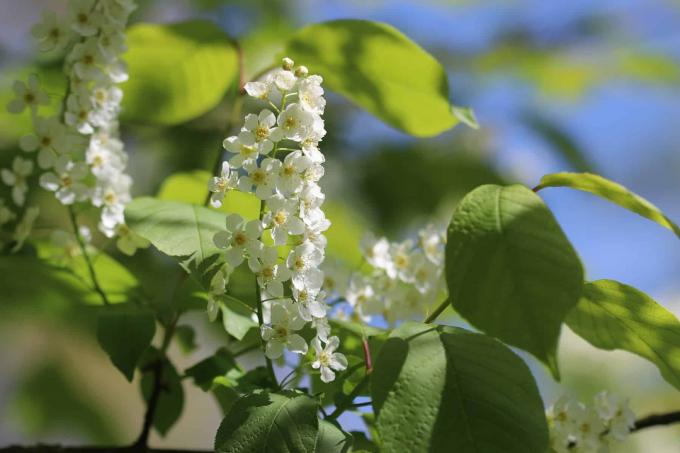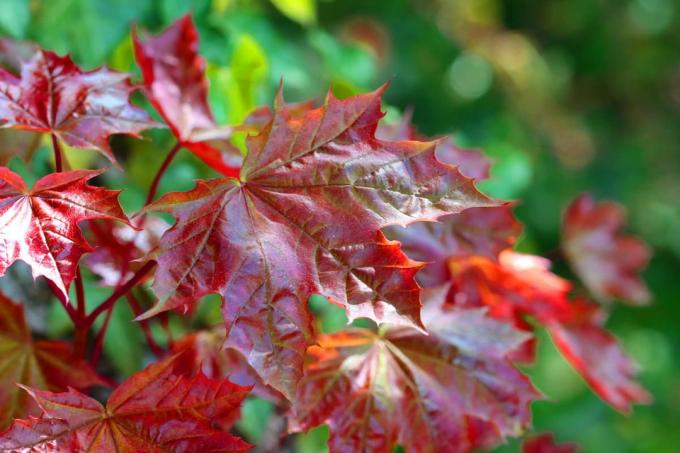

Table of contents
- Location
- substrate
- planting
- Pour
- Fertilize
- tub culture
- waste
- propagation
- wintering
- diseases and pests
Monkey tree, Chilean silver fir or Araucaria - as the plant is also called, it is an eye-catcher in the garden. The tree can grow up to five meters high and four meters wide, making it an impressive sight. The exotic look is created by triangular needles and branches arranged in a circle that grow horizontally. But what is the point of care?
Location
Finding the right location for the monkey tree is not easy. On the one hand, the Chilean ornamental fir needs a very bright planting place with sufficient light. On the other hand, it does not tolerate winter sun. A protected planting site facing north or west would therefore be suitable, where only morning and evening sun but no blazing midday sun falls on the plant.
Furthermore, sufficient space should be ensured. Araucaria grows slowly but can reach a height of five meters. Three to four meters are possible in width. Male specimens generally remain smaller than female ape trees. Nevertheless, it should not be planted too close to house walls, fences or other plants. This is particularly important because the Chilean ornamental fir should not be cut.
substrate
The ideal substrate for the monkey tree should meet the following factors:
- moist with good water storage properties
- permeable
- slightly sour
- moderate nutrient content
- low lime content

Commercial garden soil can be used as long as it does not contain too much lime. If the soil in the garden tends to compact, it can be loosened up with gravel and sand and the water drainage can be improved. If the soil does not store enough moisture, coconut fibers can be mixed in instead. On the one hand, these serve as a water reservoir and also loosen the soil.
planting
Araucaria can be cultivated both outdoors and in containers. If the Chilean silver fir is to be grown outdoors, planting after the last ground frost is crucial. The crop should therefore be used in late spring or early summer, depending on the region.
This leaves enough time for growth and hardening, but damage from ground frost is no longer to be expected.
Pour
In the event of drought, not only does the growth of the monkey tree suffer, it also develops yellow and brown discolorations very quickly. However, the plant does not tolerate waterlogging either. When casting, the following points should therefore be observed:
- Use low-lime, soft water
- pour overflowing, especially in hot, dry weather
- if necessary, also water in winter on frost-free days
- allow the top layer of soil to dry thoroughly before watering
Since low-calcium water should be used, collected rainwater or pond water are ideal. If there are not enough of these, soft tap water can also be used. In areas with hard tap water, it helps to let the water sit for a few days or a week before watering. As a result, the lime collects at the bottom of the vessel.
Fertilize
Araucaria has low nutritional requirements. During the growth phase, from around March to September, it is sufficient to give a small amount of liquid fertilizer every four to eight weeks. The less nutrient-rich the substrate, the shorter the intervals between fertilizer applications should be.
The additional nutrient supply begins when the first new shoots appear on the branches.
tub culture

The monkey tree can also be cultivated in a bucket, at least during the first few years. Here, however, there are some differences to the culture in the field in terms of care or, above all, watering and fertilizing. The differences are:
-
Choose a suitable planter:
The bucket should be stable and of sufficient size so that the monkey tree cannot tip over. Although the Araucaria grows slowly, it can attain considerable weight. It therefore also makes sense to place the bucket on a plant trolley or to choose a plant bucket with castors directly. -
Water regularly but avoid waterlogging:
To avoid waterlogging, a drainage layer should be placed in the planter. This can prevent the roots from standing in the water, even with a high coaster or cachepot. It is also important that the root ball never completely dries out. Only the top layer of soil should be allowed to dry before the next watering takes place. In summer, watering once a week or even several times a week may be necessary. Even in winter, however, the substrate should never dry out completely. -
Fertilize more often:
While fertilizing every four to eight weeks outdoors is sufficient, the Chilean silver fir should be supplied with additional nutrients every two weeks in the tub culture. Small doses of liquid fertilizer are ideal. Again, fertilization should only be done during the growing season between March and September. -
repot:
Repotting or soil change should take place when the bucket cannot provide sufficient stability, the soil is used up or roots are showing at the bottom of the pot. Experience has shown that this is only the case after two to three years. -
hibernate:
If the Chilean silver fir is cultivated in a tub, it should not be overwintered outdoors. With less substrate available, frost damage to the roots could occur. Hibernation should instead take place in a bright room at around 5°C. Watering continues, but only small amounts of water should be given.
waste

In principle, the monkey tree does not require any cuttings. In addition, the decorative shapes show up faster if this measure is omitted. However, pruning can be done if necessary.
However, care must be taken to ensure that:
- Branches are cut off directly on the trunk and twigs are cut off directly on the original branch
- no stubs remain
- blending is only done on warm, dry days
- only clean cutting tools are used
Twigs and branches should not only be partially shortened, but completely removed if trimming is necessary. Only then does cutting represent no disadvantage and no risk of promoting diseases.
Tip:
Cutting should be done when neither frost nor extremely high temperatures are to be expected. Suitable times are late spring or early fall.
propagation
The propagation of the monkey tree requires some patience, because it is done with seeds from the mature cones. However, the Chilean silver fir only flowers after about 30 years, so that obtaining seeds in your own garden is comparatively difficult. Seeds from specialist shops are an alternative.
The procedure for germinating the seeds is as follows:
- The seeds from ripe cones or from the specialist trade should not have dried before they are placed in potting soil. After training in the fall, these can be obtained directly from the cones.
- The substrate is kept moist but should not be wet. Evaporation can be reduced by covering the planters with a pane of glass or foil. However, the cover should be removed daily for a short time to avoid mold growth.
- The planters are placed in a bright and moderately warm place. A germination temperature of around 18°C to 20°C is ideal.
- After about four months they should show the first shoots. The young plants can be planted outdoors from late spring.
An alternative to this is direct sowing outdoors. For this purpose, the seeds are placed directly in the autumn at the desired planting site and covered with soil.
Tip:
Seeds from local specimens of the monkey tree are usually the best choice, as the plants are more winter hardy.
wintering

Araucaria is conditionally hardy and should be protected from severe ground frost. Overwintering outdoors is still very easy. Protective materials are simply applied to the bottom pane. Twigs, straw, mulch and fir branches are suitable for this. Jute or special protective films can also be used.
This protective layer is intended to prevent the soil from freezing through completely, thereby allowing the roots to continue absorbing water. When cultivating in a tub, the plant must be frost-free but still bright. In addition, the soil should not dry out even in winter. If necessary, small amounts of water can therefore be given on frost-free days.
diseases and pests
The monkey tree is largely resistant to both diseases and pests. However, maintenance errors can cause problems. Typical are among others:
root rot
Root rot can occur or be promoted by waterlogging and soil that tends to compact. The risk of other fungal diseases also increases if the water cannot drain sufficiently.
drought damage
Insufficient water supply can occur in both hot, dry weather and ground frost. The consequences are discoloration and dying of the needles and shoots.
frost damage
The monkey tree is hardy if it is planted outdoors in good time and here before the first frost can grow and receive adequate protection, but frost damage can occur appear. These occur primarily in connection with drought damage. If the ground is frozen, the roots cannot absorb water. It is therefore important, on the one hand, that appropriate protection is applied to the soil and, on the other hand, that it is watered on frost-free days.
burns
Especially in winter, the blazing midday sun can cause burns. This problem can only be avoided by selecting the right location.
Tip:
Adapted care can prevent the problems described.
 garden editorial
garden editorial I write about everything that interests me in my garden.
Learn more about Baumlexikon

Bird cherry, Prunus padus: caring for, pruning & propagating
The bird cherry is a shrub or tree that is the ideal bee pasture in a natural garden. However, the plant should also be viewed with caution, as it is a poisonous plant for horses. Nevertheless, it is popular in the local colorful hedges.

Red maple: 9 tips for caring for, cutting & overwintering
The red maple is one of the most impressive trees in Germany due to its unusual scarlet leaf colour. Here you can find out how to integrate this impressive plant into your garden and how to keep it healthy and vigorous.

Sycamore tree: Properly care for and cut sycamore trees
The plane tree (Platanus) has a high decorative value. In terms of care, it is mostly undemanding, which is why it is often chosen as a street tree. Nevertheless, there are a few details to be observed when it comes to care, as described in the home garden guide.

Birch locations: 5 important criteria
Birch trees are extremely frugal trees and are particularly eye-catching and decorative thanks to their light-colored bark. When choosing a location, however, a few factors should be considered in order to create optimal conditions for their growth and to protect the environment.

Cutting dwarf pine - instructions for the perfect cut
Dwarf pines can be pruned by thinning out, topiary or limbing. A bonsai design with needle and root pruning is also possible. So that the wood does not look unattractive after the pruning measure, a few rules of technology should be observed.

Is the vinegar tree poisonous? | Who is it dangerous for?
In ornamental gardens, the vinegar tree is an attractive eye-catcher due to its unusual flowers and the appealing autumn color of its feathered leaves. The red, upright fruit cobs (flowers) are responsible for the striking appearance. Despite everything, the vinegar tree is not an unproblematic tree.
